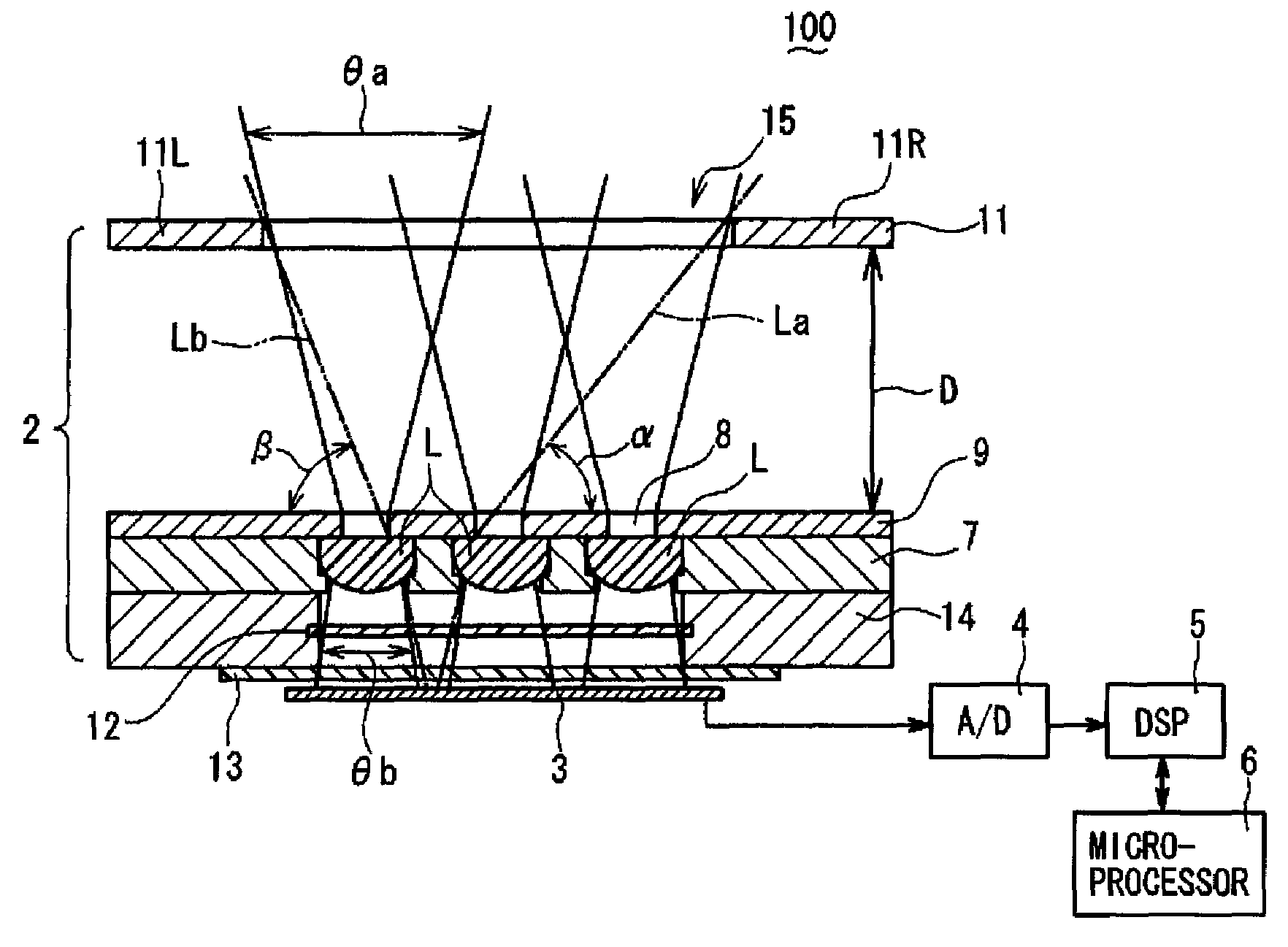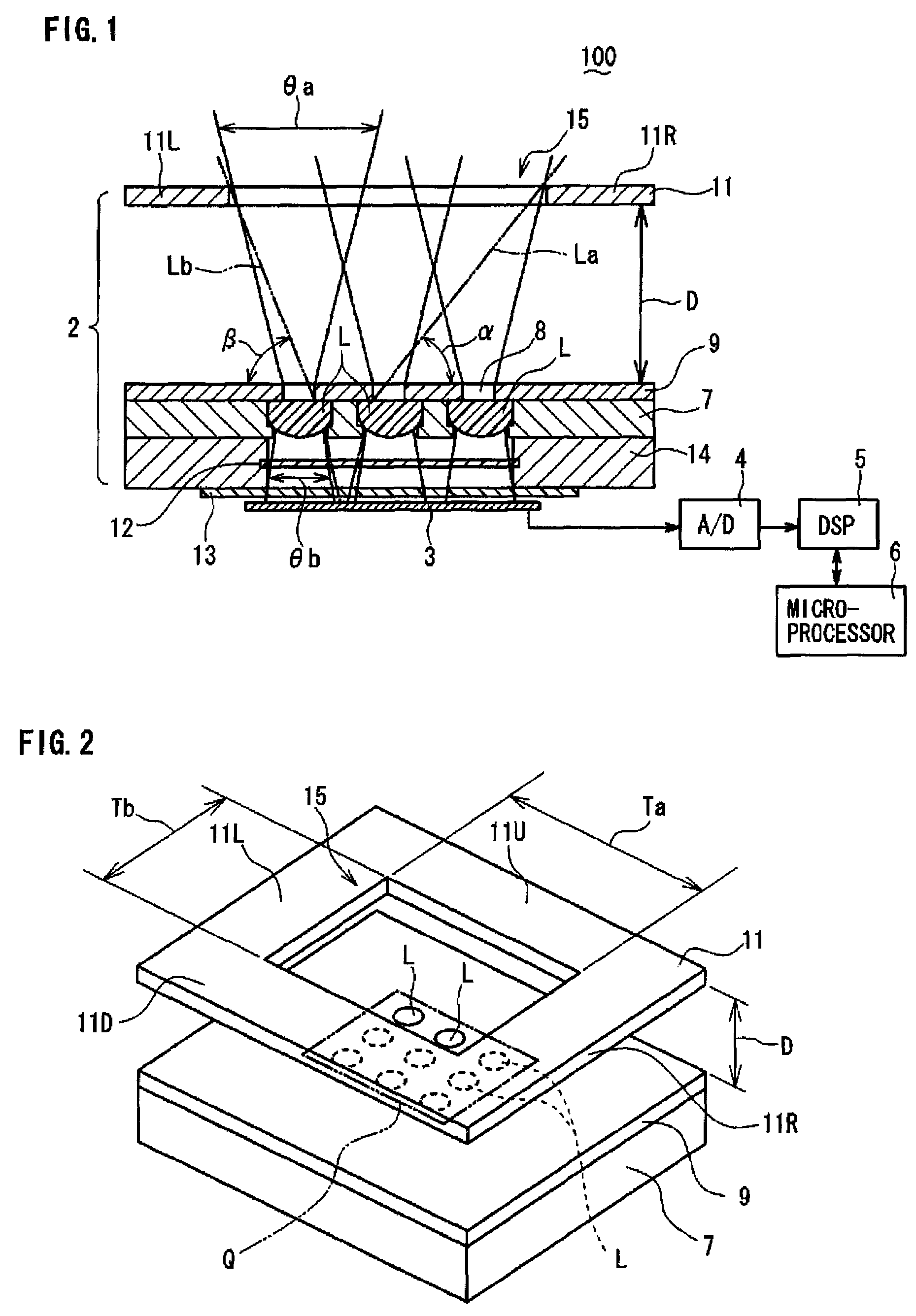Compound-eye imaging device
a compound-eye imaging and camera technology, applied in the field can solve the problems of affecting the degradation of each unit image, and the other problems so as to prevent the generation, improve the quality of compound-eye imaging devices, and avoid the effect of increasing the cost of manufacturing
- Summary
- Abstract
- Description
- Claims
- Application Information
AI Technical Summary
Benefits of technology
Problems solved by technology
Method used
Image
Examples
first embodiment
[0024]Referring to FIG. 1 to FIG. 3, a compound-eye imaging device 100 according to a first embodiment of the present invention will be described. FIG. 1 is a schematic cross-sectional view (along line X-X shown in FIG. 3) and FIG. 2 is a schematic perspective view of the compound-eye imaging device 100. As shown in FIG. 1, the compound-eye imaging device 100 comprises in a housing (not shown) thereof: an optical system 2 including optical lenses M, described later, for collecting light in a capture zone to form multiple unit images on a predetermined focal plane; and a solid-state imaging element 3 placed at the focal plane of the optical lens system 2 for converting the multiple unit images formed by the optical lens system 2 to electronic image information. The compound-eye imaging device 100 further comprises: an A / D (Analog-to-Digital) converter 4 for converting the electronic image information to digital information; a DSP (Digital Signal Processor) 5 for receiving the digital...
second embodiment
[0037]Referring to FIG. 4 and FIG. 5, a compound-eye imaging device 200 according to a second embodiment of the present invention will be described below. FIG. 4 is a schematic cross-sectional view and FIG. 5 is a schematic plan view of the compound-eye imaging device 200. The compound-eye imaging device 200 of the second embodiment has substantially the same structure as that of the compound-eye imaging device 100 of the first embodiment except for the following. First, in the compound-eye imaging device 200, the number of optical lenses L of an optical system 2 is three, in which the three optical lenses L are arranged in one row, left, center and right (refer to FIG. 5).
[0038]Second, 45-45-90 degree right-angle prisms 20L, 20R to change the propagation paths of lights to be collected on the respective optical lenses L are provided on the capture zone side of the left and right optical lenses L, respectively. Third, a stray light blocking member 21 has three windows 22L, 22C, 22R,...
third embodiment
[0041]Referring now to FIG. 6 and FIG. 7, a compound-eye imaging device 300 according to a third embodiment of the present invention will be described hereinafter. FIG. 6 is a schematic cross-sectional view and FIG. 7 is a schematic plan view of the compound-eye imaging device 300. The compound-eye imaging device 300 of the third embodiment has substantially the same structure as that of the compound-eye imaging device 200 of the second embodiment except for the following. First, in the compound-eye imaging device 300, three optical lenses L are not arranged in a row, but are arranged at the vertexes of a triangle as seen in plan view (refer to FIG. 7).
[0042]Second, each of the optical lenses L is set to have a view angle of about 40° (forty degrees), while left and right 45-45-90 degree right angle prisms 30L, 30R are set to have a mounting angle γ of about 25° (twenty-five) to the optical lenses L, respectively, so as to allow effective incident view angle ranges θc, θa, θc to con...
PUM
 Login to View More
Login to View More Abstract
Description
Claims
Application Information
 Login to View More
Login to View More - R&D
- Intellectual Property
- Life Sciences
- Materials
- Tech Scout
- Unparalleled Data Quality
- Higher Quality Content
- 60% Fewer Hallucinations
Browse by: Latest US Patents, China's latest patents, Technical Efficacy Thesaurus, Application Domain, Technology Topic, Popular Technical Reports.
© 2025 PatSnap. All rights reserved.Legal|Privacy policy|Modern Slavery Act Transparency Statement|Sitemap|About US| Contact US: help@patsnap.com



